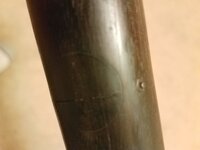Member 75122
- Messages
- 64
- Reactions
- 124
Hi everybody, I recently got a Martini-Henry Mk. IV from International Military Antiques and I noticed a sizeable horizontal crack on the underside of the stock. It's underneath the lever so it's hard to see until you pull the lever down. It looks like a small piece of metal was drilled or punched across the length of the crack. I also noticed a small vertical crack near the butt plate and noticed that when you close the breech it looks like it doesn't completely cover the chamber? I've attached photos of all of these to the best of my ability but I apologize if they're blurry or poorly lit. As you might imagine I don't plan to shoot this much but I would like to eventually load my own ammo for it. It would be quite a challenge! I'd like to take it to a gunsmith and disassemble it for a deeper cleaning but I appreciate any advice y'all can give. I've collected a number of antique and C&R firearms so I know how careful one needs to be when doing any kind of maintenance on them.






















